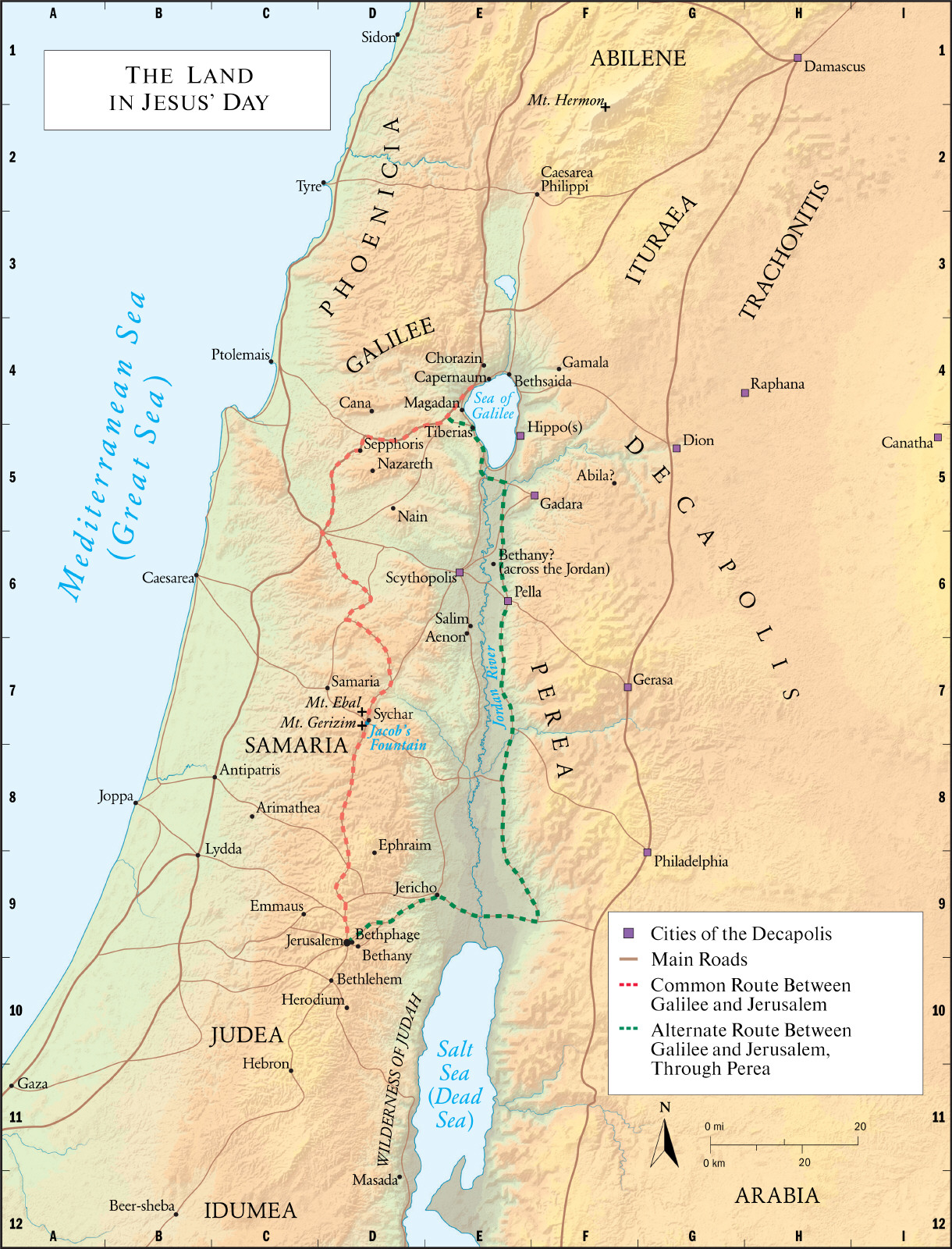The content displayed below is for educational and archival purposes only.
Unless stated otherwise, content is © Watch Tower Bible and Tract Society of Pennsylvania
You may be able to find the original on wol.jw.org
Jesus “in the Country of the Jews”

IN WITNESSING to Cornelius, the apostle Peter mentioned what Jesus did “in the country of the Jews and in Jerusalem.” (Ac 10:39) What areas do you think were included in Jesus’ history-making ministry?
“The country of the Jews” included Judea, where Jesus did some of God’s work. (Lu 4:44) After being baptized, Jesus spent 40 days in the wilderness of Judah (or, Judea), a rather arid and desolate region frequented by rebels and bandits. (Lu 10:30) Later, Jesus was traveling northward from Judea when he witnessed to a Samaritan woman near Sychar.—Joh 4:3-7.
A review of the Gospels shows that Jesus concentrated on Galilee. Though he went south to Jerusalem for annual festivals, he spent most of the first two years of his ministry in the northern part of the Promised Land. (Joh 7:2-10; 10:22, 23) For example, he outlined many notable teachings and performed impressive miracles while near or on the Sea of Galilee. Recall that he calmed its stormy waters and even walked on it. He preached from boats to crowds on the pebbly shores of that sea. His early, close followers were from fishing and farming communities nearby.—Mr 3:7-12; 4:35-41; Lu 5:1-11; Joh 6:16-21; 21:1-19.
The base for Jesus’ Galilean ministry was shoreside Capernaum, “his own city.” (Mt 9:1) He was on a hillside not far away when he gave his famous Sermon on the Mount. On occasion, he went by boat from the Capernaum area to Magadan, Bethsaida, or nearby spots.
Note that Jesus’ “own city” was not very far from Nazareth, where he grew up; from Cana, where he turned water into wine; from Nain, where he raised the son of a widow; and from Bethsaida, where he miraculously fed 5,000 men and restored sight to a blind man.
After the Passover of 32 C.E., Jesus went north toward Tyre and Sidon, Phoenician ports. Then he extended his ministry to some of the ten Hellenized cities called the Decapolis. Jesus was near Caesarea Philippi (F2) when Peter acknowledged him as the Messiah, and the transfiguration soon followed, perhaps on Mount Hermon. Later, Jesus preached in the region of Perea, across the Jordan.—Mr 7:24-37; 8:27–9:2; 10:1; Lu 13:22, 33.
Jesus spent his last week on earth with his disciples in and around Jerusalem, “the city of the great King.” (Mt 5:35) You can find nearby places that you have read about in the Gospels, such as Emmaus, Bethany, Bethphage, and Bethlehem.—Lu 2:4; 19:29; 24:13; see “Jerusalem Area,” inset on page 18.
[Map on page 29]
(For fully formatted text, see publication)
Promised Land (Jesus’ time)
The Land in Jesus’ Day
Cities of the Decapolis
E5 Hippo(s)
E6 Pella
E6 Scythopolis
F5 Gadara
F7 Gerasa
G5 Dion
G9 Philadelphia
H1 Damascus
H4 Raphana
I5 Canatha
Main Roads (See publication)
Common Route Between Galilee and Jerusalem (See publication)
Alternate Route Between Galilee and Jerusalem, Through Perea (See publication)
A11 Gaza
B6 Caesarea
B8 Joppa
B9 Lydda
B12 Beer-sheba
C4 Ptolemais
C8 SAMARIA
C8 Antipatris
C8 Arimathea
C9 Emmaus
C10 JUDEA
C11 Hebron
C12 IDUMEA
D1 Sidon
D2 Tyre
D3 PHOENICIA
D4 GALILEE
D4 Cana
D5 Sepphoris
D5 Nazareth
D5 Nain
D7 Samaria
D7 Sychar
D9 Ephraim
D9 Bethphage
D9 Jerusalem
D9 Bethany
D10 Bethlehem
D10 Herodium
D10 WILDERNESS OF JUDAH
D12 Masada
E4 Chorazin
E4 Bethsaida
E4 Capernaum
E4 Magadan
E5 Tiberias
E5 Hippo(s)
E6 Bethany? (across the Jordan)
E6 Scythopolis
E6 Pella
E6 Salim
E6 Aenon
E9 Jericho
F1 ABILENE
F2 Caesarea Philippi
F4 Gamala
F5 Abila?
F5 Gadara
F7 PEREA
F7 Gerasa
G3 ITURAEA
G5 Dion
G6 DECAPOLIS
G9 Philadelphia
H1 Damascus
H3 TRACHONITIS
H4 Raphana
H12 ARABIA
I5 Canatha
[Mountains]
D7 Mt. Ebal
D7 Mt. Gerizim
F2 Mt. Hermon
[Bodies of water]
B6 Mediterranean Sea (Great Sea)
E4 Sea of Galilee
E10 Salt Sea (Dead Sea)
[Rivers]
E7 Jordan River
[Springs and wells]
D7 Jacob’s Fountain
[Picture on page 28]
Sea of Galilee. Capernaum is in the left foreground. View is southwest across the Plain of Gennesaret
[Picture on page 28]
Samaritans worshiped on Mount Gerizim. Mount Ebal is in the background